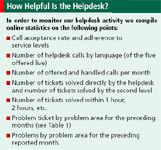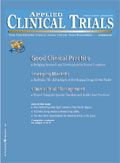The EDC Decision
Boehringer International implemented a holistic approach to electronic data capture, boosting quality and efficiency.
All pharmaceutical companies seek to improve efficiency in clinical trials data collection; this is no less the case for Boehringer International (BI).

Boehringer first approved the principle of using electronic data capture (EDC) in 2001, with the goal to evaluate the best technologies available on the market in order to see if we could further improve quality and our performance. At the same time, we needed to be careful to ensure that any changes would not affect quality regarding the management of clinical data. In addition, it was clear for BI that EDC had the potential to reduce the effort needed during the conduct of the study and to speed up the collection of clean data in the database.

How Helpful Is the Helpdesk?
The RDC (Remote Data Capture) system Oracle Clinical (O*C) was chosen as our EDC tool, and we were therefore able to integrate our new clinical data with existing clinical trials databases. Because O*C is the clinical data management system that has been in use by Boehringer since 1997, the data management setup activities went very smoothly, since the study programmers were already trained to operate this application. Our target concerning RDC deployment is 100% of BI clinical trials by 2007. By the beginning of 2006, we were running about 40% of our trials in RDC.

Savings Derived from Remote Data Capture
The key RDC benefits identified were:
- Early decision making; the information is processed and shared at the time of the data collection, eliminating the need to wait for the CRA's source data verification (SDV) monitoring visit.
- Elimination of paper queries back to site; data validation is performed during and just after data entry.
- Investigators save time, primarily in dealing with discrepancies.
- Analysis of data can start more quickly.
- Better quality of the data; the data are cleaned just after data entry (see Table 1).
- Information is shared remotely with all of the clinical study staff at the site and sponsor levels, so everyone sees the same view of the data.
- Reduced time frame between the last patient out and database lock.
Strategy implementation and helpdesk
Boehringer has hired a vendor, Hewlett Packard (HP), which is in charge during the start of the study of checking that the Investigator's sites have appropriate equipment, Internet connections, and BI notebook deployment if needed.
Furthermore, HP also acts as a hotline, an RDC helpdesk, which during the conduct of the study offers assistance 24 hours a day, seven days a week in English and five days a week in German, French, Italian, and Spanish. A "language line" is used to provide translation service in about 120 different languages.
RDC training
Boehringer has chosen to develop a Web-Based Training (WBT), program to complete the RDC training, which is accessible with an Internet browser. The training includes interactive simulations, quizzes, and useful illustrations and tips.
Two different user groups were identified for this training, the Site Users and the CRAs. At the end of the course, the trainees have to print a certificate, which is mandatory to obtain a SecurID token and password, and thereby access to the study.
Costs versus savings
It is not simple to give direct evidence regarding savings and costs, but we can observe some indications. We have separated two approaches of savings—the visible and the derived. From my point of view, the derived savings are the most important.
Conclusion
We have encountered certain technical hitches along the way, such as unavailability of Internet connection on site and issues concerning on-site internal security measures (firewall configuration, etc.). Issues such as these, however, will in the future likely be remedied by the further roll out of wireless technologies.
One of the crucial factors for the success of RDC implementation at BI has been the holistic approach we applied to the integration with our existing CDMS. Our client-oriented focus, such as the suite of user-friendly RDC software, clear Web-based training, and helpdesk availability, has also been a key contributing factor.
We remain convinced that RDC is an effective tool to improve the quality and efficiency of our clinical data and is here to stay.
Stéphane Collet is head of data management and clinical trial support with Boehringer Ingelheim France, 12, rue André Huet, B.P. 292, F-51060 Reims cedex, France.

Improving Relationships and Diversifying the Site Selection Process
April 17th 2025In this episode of the Applied Clinical Trials Podcast, Liz Beatty, co-founder and chief strategy officer, Inato, discusses a number of topics around site engagement including community-based sites, the role of technology in improving site/sponsor relationships, how increased operational costs are impacting the industry, and more.